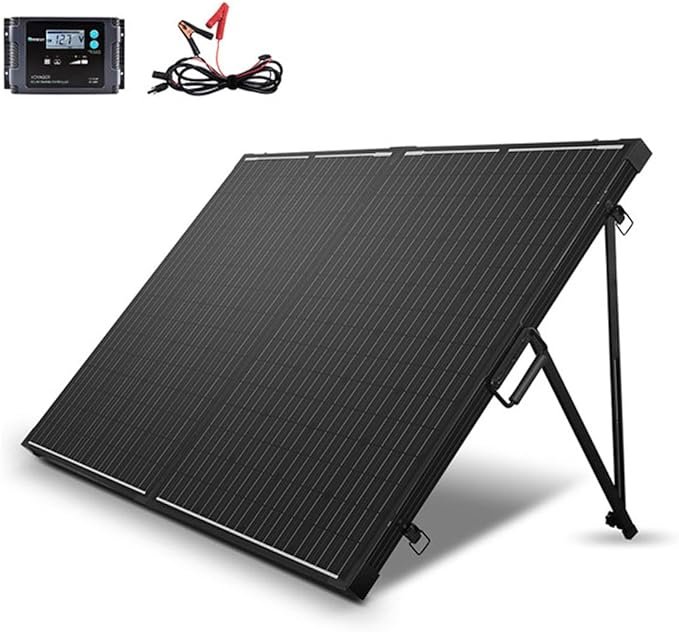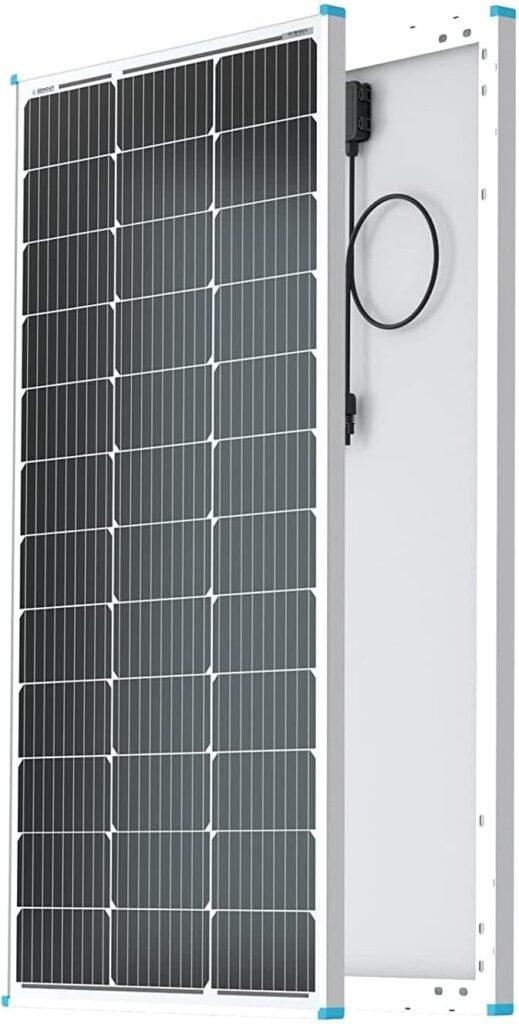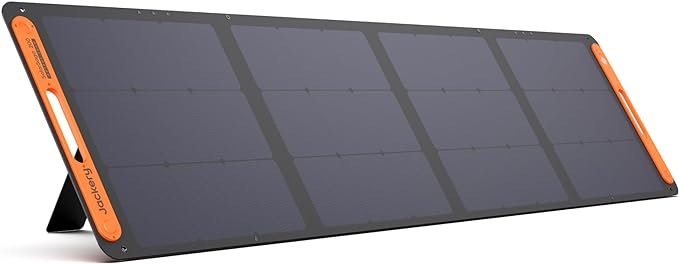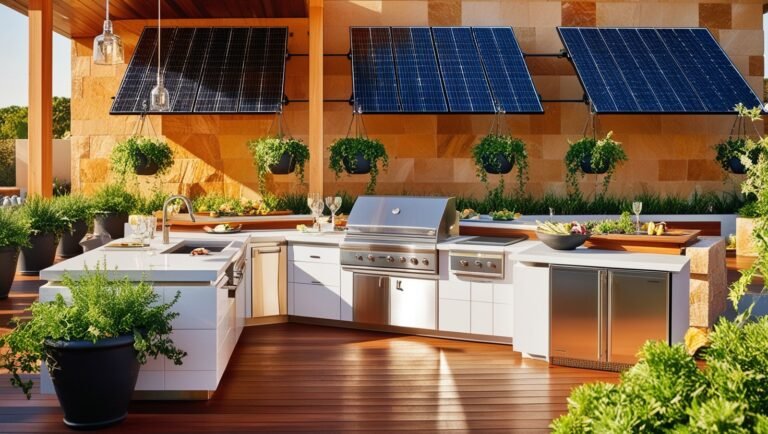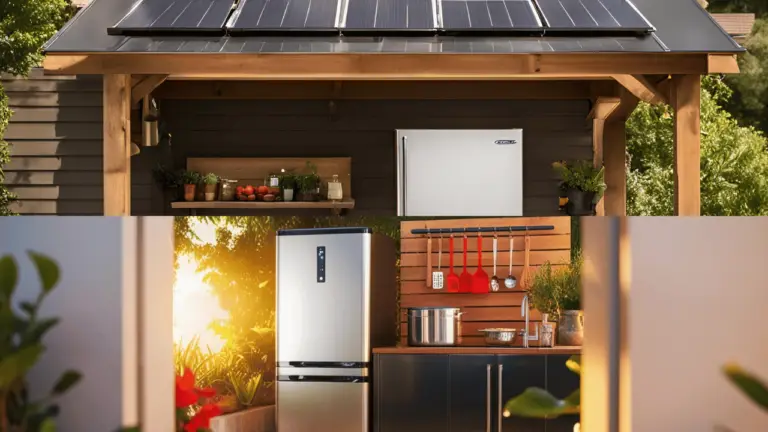Are you ready to embark on the adventure of a lifetime in your RV, all while harnessing the power of the sun? You’re in for a treat! In this comprehensive guide, we’ll explore everything you need to know about portable solar panels for RVs. From understanding the basics to choosing the perfect setup for your home on wheels, we’ve got you covered. So buckle up, and let’s dive into the world of renewable energy for your RV lifestyle!
Introduction: Powering Your Freedom

Picture this: You’re parked at a breathtaking campsite, surrounded by nature’s beauty, with not a power hookup in sight. But instead of worrying about your battery life, you’re relaxing with a cold drink, your devices fully charged, and your RV humming along on clean, free energy from the sun. That’s the magic of portable solar panels for RVs!
Did you know that over 60% of RV owners now consider solar power a must-have for their adventures? It’s no wonder – with advancements in technology and decreasing costs, portable solar panels for RVs have become a game-changer for the RV community. In this guide, we’ll explore why solar power is revolutionizing the RV experience and how you can join the movement.
Understanding Portable Solar Panels for RVs
What Are Portable Solar Panels?
Portable solar panels are compact, lightweight photovoltaic modules designed to capture sunlight and convert it into usable electricity. Unlike fixed solar installations, these panels can be easily moved, stored, and set up wherever your RV adventures take you.
How Do They Work?
- Solar cells in the panels absorb sunlight
- The absorbed light creates an electric current
- A charge controller regulates the current flow to your RV’s batteries
- Batteries store the energy for later use
- An inverter converts the stored DC power to AC power for your appliances
Types of Portable Solar Panels for RVs
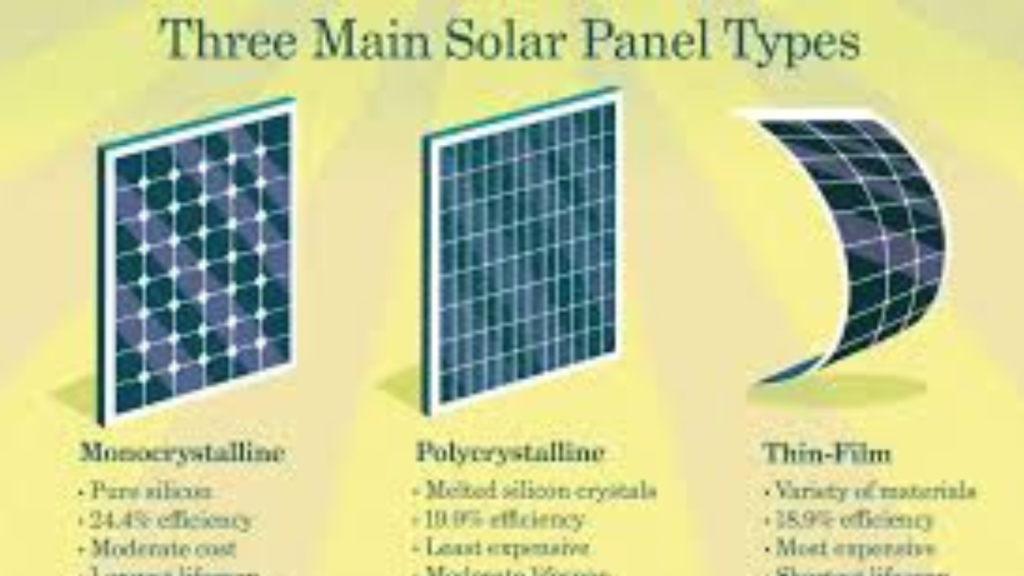
- Monocrystalline Panels: High efficiency, sleek black appearance
- Polycrystalline Panels: Lower cost, slightly less efficient
- Thin-Film Panels: Ultra-lightweight and flexible, but less efficient
Benefits of Using Portable Solar Panels for Your RV

- Energy Independence: Free yourself from the grid and campground hookups
- Cost Savings: Reduce or eliminate generator fuel costs and campground fees
- Eco-Friendly: Lower your carbon footprint with clean, renewable energy
- Quiet Operation: Enjoy the sounds of nature without a noisy generator
- Low Maintenance: Solar panels require minimal upkeep
- Extended Battery Life: Consistent charging reduces battery strain
Choosing the Best Portable Solar Panels for Your RV
Factors to Consider
- Power Output: Measure in watts – higher wattage means more power generation
- Efficiency: Look for panels with higher conversion rates
- Size and Weight: Consider your RV’s available space and weight limits
- Durability: Opt for panels designed to withstand outdoor conditions
- Compatibility: Ensure the panels work with your existing RV electrical system
- Expandability: Choose a system that allows for future upgrades
Top 5 Portable Solar Panels for RVs in 2024
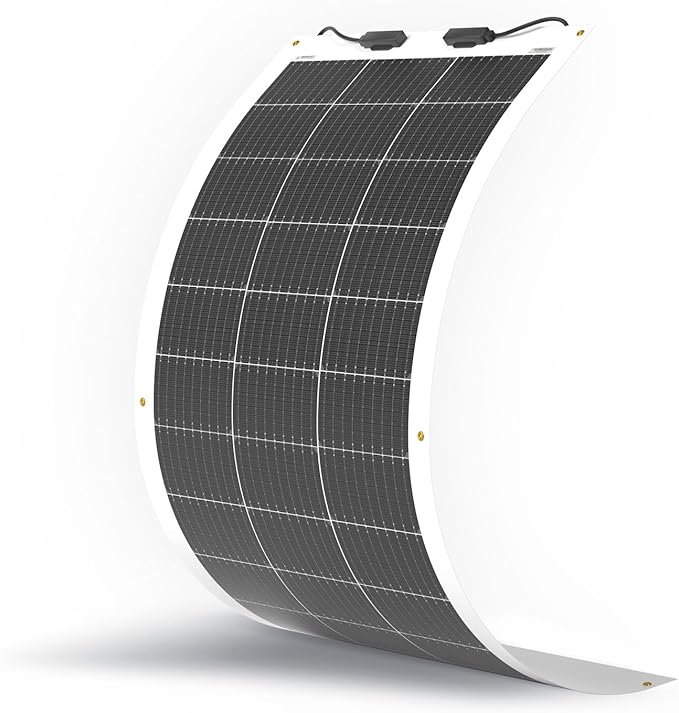
Renogy Flexible Solar Panel 100 Watt
Key Features
- Extremely Flexible: Designed for versatile applications, especially on curved surfaces like the roof of an Airstream.
- Ultra Lightweight: Made with advanced polymer materials, this panel weighs 70% less than conventional panels, easing transportation and installation.
- Super Thin Lamination: At just a tenth of an inch thick, this panel is approximately 95% thinner than rigid counterparts, making it ideal for stealthy installations.
- Highly Durable: Rigorously tested to endure extreme wind up to 2400 Pa and snow loads up to 5400 Pa.
- Potential Uses: Suitable for off-grid applications including marine, rooftop, RV, boats, and any curvy surfaces.
Pros and Cons
| Pros | Cons |
|---|---|
| Flexible Design: Fits curved surfaces easily. | Lower Efficiency: May have slightly lower efficiency compared to rigid panels. |
| Ultra Lightweight: Easier to transport and install. | |
| Super Thin: Discreet and ideal for stealth installations. | |
| Highly Durable: Withstands extreme weather conditions. | |
| Versatile Applications: Ideal for various off-grid uses. |
Key Features
- Plug and Play Kit: Includes a 200W solar suitcase, 20A waterproof Voyager charge controller, and alligator clips. Works with various 12V batteries.
- High Efficiency: Uses grade A+ monocrystalline solar cells and advanced PWM technology for optimal charging.
- Foldable Design: Portable, easy to store, and set up.
- Safety: Smart PWM controller with multiple protections for safe charging.
- Durable: Comes with a rugged protective case and weather-resistant backplanes, backed by a 5-year warranty.
Pros and Cons
| Pros | Cons |
|---|---|
| Easy Setup: Plug and play with various 12V batteries. | Higher Cost: Complete kit may be pricey. |
| Efficient: Advanced cells and technology for effective charging. | |
| Portable: Foldable for convenience. | |
| Safe: Multiple protections ensure safe use. | |
| Durable: Long-lasting with a 5-year warranty. |
Key Features
- Stable Output: 100W panel delivers an average of 500Wh per day. Weighs 14.1 lbs, 8-10% lighter and smaller than conventional panels.
- Superior Quality: Made from 100% EL-tested Grade A+ cells and PERC technology, offering 22% efficiency.
- Advanced Tech: Features 9 Bus-bars and Half-cell structure for maximized space and efficiency.
- Built to Last: IP65-rated, durable in all weather conditions with low iron-tempered glass and corrosion-resistant aluminum frame.
- Easy Installation: 20 pre-drilled holes for quick mounting, compatible with Renogy mounts.
- Durable Warranty: 10-year workmanship warranty, with over 80% output at 25 years.
Pros and Cons
| Pros | Cons |
|---|---|
| Compact and Lightweight: 8-10% lighter and smaller than rigid panels. | Limited to Renogy Mounts: Best with Renogy-specific mounts. |
| High Efficiency: 22% efficiency with Grade A+ and PERC cells. | Not Foldable |
| Durable: IP65 protection and robust construction for all-weather use. | Fixed Size |
| Easy Installation: Pre-drilled holes for quick and versatile mounting. | |
| Long Warranty: 10-year workmanship warranty and strong long-term output. |
Key Features
- Peak Performance: Advanced monocrystalline solar cells with IBC technology achieve up to 24.3% conversion efficiency, outperforming conventional panels, especially in low-light conditions.
- Easy Setup: Designed for quick, hassle-free setup in just 10 seconds. Compatible with all Jackery Portable Power Stations and Solar Generators, with an ergonomic handle for easy transport.
- Maximum Durability: IP68-rated for extreme weather resistance, featuring an ETFE-laminated case for enhanced durability and long-term performance.
- Ultra Fast Solar Charging: 200W power rating enables a full charge in just 2.5 hours when connected to 6 SolarSaga 200W panels. Fully compatible with Jackery’s range of power stations.
- Intelligent Sunlight Tracking: SolarTarget technology automatically adjusts panel positioning throughout the day for optimal sunlight capture and maximized power generation.
Pros and Cons
| Pros | Cons |
|---|---|
| High Efficiency: 24.3% conversion efficiency, superior performance in low light. | Expensive |
| Quick Setup: Fast and easy 10-second setup with ergonomic design. | May be heavier than some portable options. |
| Durable Build: IP68-rated and ETFE-laminated for long-lasting use. | |
| Rapid Charging: 200W rating allows for ultra-fast charging, perfect for on-the-go use. | |
| Smart Tracking: SolarTarget ensures optimal sunlight capture all day. |

BLUETTI PV200 200W: High conversion efficiency and IP65 water-resistant
Key Features
- Material: Made from high-efficiency Monocrystalline Silicon, ensuring up to 23.4% efficiency in solar energy conversion.
- Power Output: Delivers a maximum power of 200 watts, ideal for various off-grid applications.
- Dimensions & Weight: Measures 89.2″L x 23.2″W x 1.99″H, and weighs 16.1 pounds, making it portable yet powerful.
- Included Components: Comes with a solar panel, a 120-inch solar connector cable, and an adjustable kickstand for optimal positioning.
- Connector Type: Equipped with a solar connector for seamless integration with your setup.
- Warranty: Backed by a 12-month warranty, providing peace of mind and reliability.
Pros and Cons
| Pros | Cons |
|---|---|
| High Efficiency: 23.4% conversion rate, excellent for energy generation. | At 16.1 pounds, it may be heavier than some portable panels. |
| Powerful Output: 200 watts, suitable for a range of uses. | Limited Warranty: Only a 12-month warranty period. |
| Durable Build: Sturdy construction with adjustable kickstand. | No Batteries: Batteries are not included, requiring additional purchase if needed. |
| Easy Integration: Solar connector for quick setup. | Origin: Manufactured in China, which may concern some buyers. |
| Portable Design: Compact and portable despite its power capacity. |
Setting Up Your Portable Solar Panels For RVs System
Essential Components
- Solar Panels
- Charge Controller
- Deep Cycle Batteries
- Inverter
- Wiring and Connectors
- Mounting Hardware (if desired)
Step-by-Step Installation Guide
- Determine your power needs by calculating your daily energy consumption
- Choose the appropriate size and number of solar panels
- Select a suitable location on your RV for panel placement
- Install the charge controller near your RV’s battery bank
- Connect the solar panels to the charge controller
- Wire the charge controller to your RV’s batteries
- Install an inverter if you need AC power
- Test the system and monitor performance
Tips for Optimal Performance
- Keep panels clean and free from debris
- Angle panels towards the sun for maximum exposure
- Use a solar charge controller with MPPT technology for better efficiency
- Invest in quality deep cycle batteries for energy storage
- Consider a tilting mount to adjust panel angle with the seasons
CHECK MY POST ON SIMPLE ANGLE PANEL POSITIONING TO ATTAIN MAXIZMUM EFFICIENCY
Maximizing Efficiency: Best Practices for RV Solar Power
- Energy Conservation: Use LED lights and energy-efficient appliances
- Smart Power Management: Run high-draw appliances during peak sunlight hours
- Battery Maintenance: Regularly check and maintain your battery bank
- Shade Management: Position your RV to minimize shadows on solar panels
- Seasonal Adjustments: Alter panel angles to optimize for sun position throughout the year
CLICK TO CHECK OUT THE COMMON WAYS TO SET UP A SOLAR PANEL SYSTEM
Troubleshooting Common Issues
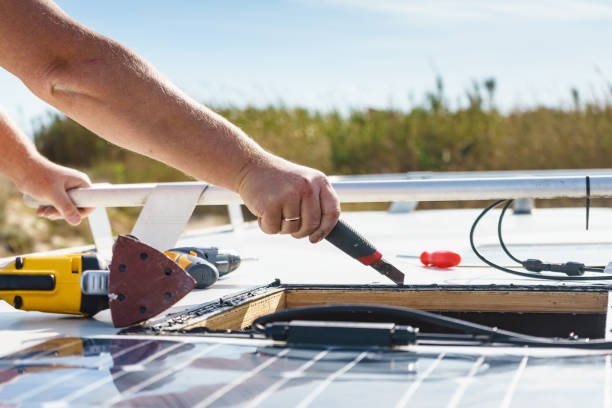
- Low Power Output
- Clean panels and check for shading
- Verify all connections are secure
- Test charge controller functionality
2. Battery Not Charging
- Check battery voltage and health
- Inspect wiring for damage or loose connections
- Verify charge controller settings
3. Inverter Problems
- Ensure proper sizing for your power needs
- Check for error codes and consult manual
- Verify input voltage is within acceptable range
The Future of RV Solar Power
As technology advances, we can expect to see even more exciting developments in portable solar panels for RVs:
- Higher Efficiency Panels: Increased power output from smaller panels
- Integrated Solar Solutions: RVs with built-in, aerodynamic solar systems
- Smart Energy Management: AI-powered systems to optimize power usage
- Improved Energy Storage: Advanced battery technologies for longer-lasting power
CHECK MY BLOG POST ON THE BEST POTABLE SOLAR PANELS
Environmental Impact: Going Green on the Go
By choosing portable solar panels for your RV, you’re not just saving money – you’re also making a positive impact on the environment:
- Reduced Carbon Emissions: Solar power is clean and renewable
- Less Noise Pollution: Say goodbye to noisy generators
- Minimal Impact on Campsites: Leave no trace with your energy production
- Increased Awareness: Inspire others to adopt sustainable RV practices
CHECK MY BLOG POST ON THE Environmental Impact OF SOLAR IF THEY ARE ARTICULLY ECO-FRIENDLY
FAQs: Everything You Need to Know About Portable Solar Panels for RVs
- Q: How many solar panels do I need for my RV?
A: The number of panels depends on your energy consumption. Calculate your daily power usage in watt-hours and divide by the average sun hours in your travel areas. This will give you an estimate of the total wattage needed. - Q: Can I use portable solar panels in cloudy weather?
A: Yes, solar panels still work on cloudy days, but at reduced efficiency. Expect about 10-25% of normal power output on overcast days. - Q: How long do portable solar panels last?
A: Quality portable solar panels can last 20-25 years with proper care. However, their efficiency may decrease slightly over time. - Q: Do I need to remove snow from my solar panels?
A: Yes, snow can significantly reduce power output. Gently remove snow using a soft brush or specialized tool to avoid damaging the panels. - Q: Can I connect portable solar panels to my RV’s existing battery?
A: Yes, but ensure you use a proper charge controller to regulate the power flow and protect your battery. - Q: Are portable solar panels waterproof?
A: Many are water-resistant, but not all are fully waterproof. Check the IP rating of your panels and protect them during heavy rain. - Q: How do I clean my portable solar panels?
A: Use a soft cloth or sponge with mild soap and water. Avoid abrasive materials or harsh chemicals that could damage the panel surface. - Q: Can I use portable solar panels while driving my RV?
A: It’s possible but not recommended due to safety concerns and potential legal issues. It’s best to charge while parked. - Q: Do I need a special RV roof to install solar panels?
A: Most RV roofs can accommodate solar panels, but check weight limits and consider using a mounting system designed for your RV type. - Q: How do I store portable solar panels when not in use?
A: Store them in a cool, dry place, preferably in a protective case. Avoid stacking heavy items on top of the panels. - Q: Can portable solar panels overcharge my RV batteries?
A: A quality charge controller will prevent overcharging by regulating the power flow to your batteries. - Q: Are portable solar panels worth the investment for occasional RV use?
A: Even for occasional use, solar panels can be worthwhile. They extend battery life, provide independence, and can increase your RV’s resale value. - Q: How do I know if my portable solar panels are working efficiently?
A: Monitor your power generation using a solar charge controller with a display or a separate solar power meter. - Q: Can I mix different types or brands of solar panels?
A: It’s possible but not recommended. Mixing panels can lead to reduced efficiency and potential compatibility issues. - Q: Do I need a permit to install solar panels on my RV?
A: Generally, no permit is required for portable or temporary installations on RVs. However, check local regulations if you plan a permanent mount.
Conclusion: Embrace the Solar-Powered RV Lifestyle
As we’ve explored in this comprehensive guide, portable solar panels for RVs are more than just an accessory for your RV – they’re a gateway to a more sustainable, cost-effective, and liberating travel experience. By harnessing the power of the sun, you’re not only reducing your environmental impact but also expanding your horizons, allowing you to venture further off the beaten path with confidence.
Remember, the journey to solar-powered RV living is unique for everyone. Take the time to assess your needs, research your options, and don’t hesitate to seek advice from fellow RV enthusiasts or solar experts. With the right setup, you’ll be well on your way to endless adventures, powered by nothing but sunshine and wanderlust.
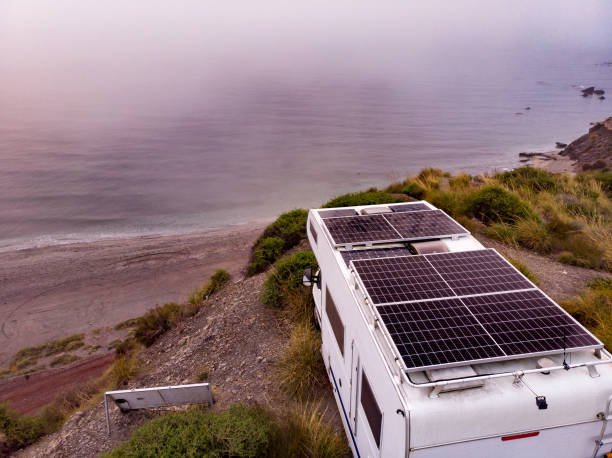
So, are you ready to join the solar revolution and transform your RV into a self-sufficient, eco-friendly home on wheels? The open road is calling, and with portable solar panels, you’re more prepared than ever to answer that call. Here’s to sunny skies, full batteries, and the freedom to roam wherever your heart desires!
Happy travels, and may your journey be forever brightened by the power of solar energy!

